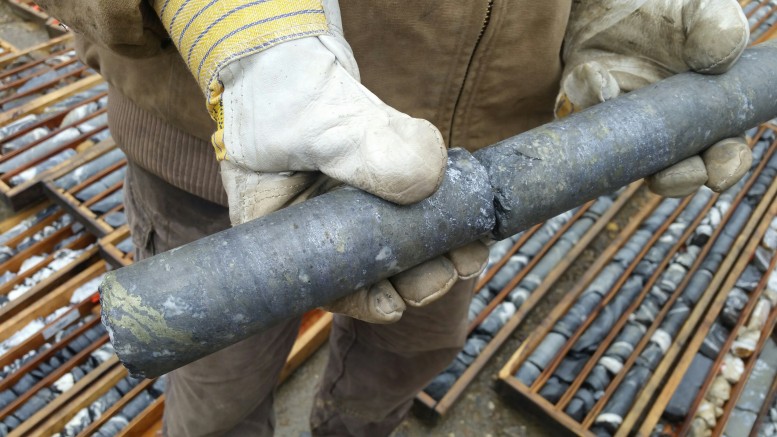VANCOUVER — Taranis Resources (TSXV: TRO; US-OTC: TNREF) is blazing a new path at its Thor polymetallic deposit, 8 km northeast of Trout Lake in southeastern B.C., ever since backing out of an opportunity last year to buy a 65% stake in the nearby Max mine and mill.
The company was considering using the mothballed 1,000-tonne-per-day facility, which was owned by FortyTwo Metals, a subsidiary of beleaguered molybdenum miner Roca Mines, to expedite development at Thor.

Aerial view of the True Fissure to Broadview targets at Taranis Resources Thor property in B.C. Credit: Taranis Resources.
But after looking at the high number of creditors and the potential liabilities associated with the former mine’s tailings pond, Taranis president and CEO John Gardiner tells The Northern Miner during an interview that his company took a pass on the Max deal, and is looking at new options.
“Our goal is to expand Thor’s resource to beyond 2.5 million tonnes. When you can place that amount of material on the table with the kind of grades we’re getting, it changes the economics of the deposit,” Gardiner says. “With that critical size in hand, there are a lot more options on how to push the project forward, whether it will become a standalone operation or not.”
Taranis completed 2,100 metres of drilling at Thor this year, aimed at expanding known mineralization. The volcanogenic massive sulphide deposit has four main zones — Broadview, Great Northern, True Fissure and Blue Bell — which occur across a 2 km strike along the eastern flank of a sheared, northwest-trending fold.

Taranis Resources’ president and CEO John Gardiner at the Thor polymetallic deposit, 8 km northeast of Trout Lake in southeastern B.C. Credit: Taranis Resources.
A study by Roscoe Postle Associates in 2013 estimated that Great Northern, True Fissure and Blue Bell contain an open-pittable, 471,000 indicated tonnes of 0.91 gram gold per tonne, 204 grams silver per tonne, 0.1% copper, 2.8% lead and 3.7% zinc; and 189,000 inferred tonnes of 1.28 grams gold, 218 grams silver, 0.2% copper, 2.7% lead and 3.8% zinc.
The drilling identified stacked mineralization zones beneath Great Northern, with intercepts returning 2.3 metres of 0.53 gram gold, 683.8 grams silver, 0.3% copper, 4.4% lead and 4.5% zinc from 34 metres deep, and 3 metres of 0.27 gram gold, 229.6 grams silver, 0.1% copper, 2.6% lead and 3.8% zinc from 65 metres deep.
“These underlying zones show there’s room for resource expansion outside the areas surveyed in the 2013 estimate,” Gardiner says. “Now that we have a handle on the geology of the deposit, we know in some areas we have to drill deeper than the first zone we hit.”
Other drill holes targeting new mineralization zones east of Great Northern found 9.1 metres of 1.05 grams gold, 143.9 grams silver, 1.8% lead and 3.8% zinc from 72 metres deep, and 9.1 metres of 0.74 gram gold, 97.7 grams silver, 3.3% lead and 5.8% zinc from 35 metres deep.
Taranis plans to publish a global resource for the project next year, but first the company wants to drill up to 10,000 metres at the less explored Broadview and Scab zone targets at Thor.
Broadview holds 500 metres of the total mineralized strike length, whereas Scab zone is a 450-metre-long portion between the True Fissure and Blue Bell mines. Gardiner says both target areas have had little to no drilling, because they are in steep areas that require specialized, small drills.
Scab zone forms a large, gossanous outcrop of quartz-sulphide breccia at least 250 metres in strike and 100 metres in dip, where seven grab samples averaged 4.6 grams gold, 535.2 grams silver, 0.3% copper, 8.9% lead and 4.38% zinc.
“We’re of a firm impression that by [mid-2017] we’ll outline a sizeable deposit,” Gardiner says. “We just have to keep our nose to the grindstone.”

Metallurgical test mill to process gold from Taranis Resources SIF gold zone at its Thor property in B.C. Credit: Taranis Resources.
Taranis also aims to recover a 1,000-tonne bulk sample from the project’s SIF zone, an exposed gold-rich quartz vein that sits in the nose of a fold along Thor’s main structural trend. The company bought a turnkey processing plant last July, and expects the work will get underway by June.
“We envision Thor as a bite-sized operation, rather than these mammoths you normally see out there,” Gardiner says. “Because of its small size, you can be a lot more surgical in terms of the grades you’re going to produce, and the amount of equity you’ll need to build a mine on the project. They’re a lot more budget friendly than some of the other big projects, and much easier to permit.”
Taranis shares have traded within a 52-week range of 4¢ to 15¢ per share, and closed at 11¢ at press time. It has 49.8 million shares outstanding for a $4.8-million market capitalization.


Be the first to comment on "Taranis seeks growth at Thor"